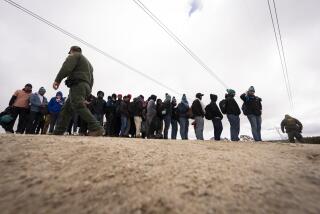U.S. Rules on Asylum Due for Major Changes
In a move expected to have significant impact on Southern Californiaâs burgeoning refugee population, the U.S. government has issued major changes in the way asylum is granted to aliens who fear persecution at home and seek haven here.
The new guidelines, which take effect Oct. 1 and will cost up to $9 million to implement, come after a decade of legal debate and negotiation and are intended, in part, to answer critics who say asylum has not always been granted even-handedly or efficiently.
Under the revamped system, a corps of specially trained âasylum officersâ will be established, some standards for proving asylum cases will be eased and the influence of the U.S. State Department could be diminished.
The changes could have particular impact in Southern California, home to one of every four U.S. asylum applicants. Proponents say that Central Americans, who account for nearly 80% of todayâs asylum-seekers and almost all those who apply in Los Angeles, stand to benefit the most from the new policy.
âWe could be at the outset of an interesting era,â said Arthur C. Helton, director of the refugee project of the Lawyers Committee for Human Rights and a principal lobbyist for the changes.
Critics have long complained that the granting of asylum has reflected a âforeign policy biasâ injected by the State Department, which determines the countries where refugees face persecution. They claim that refugees from countries with governments supported by Washington are denied asylum much more readily than applicants from countries considered âenemies.â The Immigration and Naturalization Service, which grants asylum based on State Department recommendations, has long denied the claim.
Several lawsuits in recent years have complained that âinsensitiveâ INS agents operating under a âlaw-enforcement mentalityâ mishandle asylum cases by conducting interviews that are hostile, too short, lacking in privacy or in languages the applicants do not understand.
Helton and others cautioned that it will depend on how the new rules are put into practice before anyone can predict whether asylum adjudications will be more fair.
The changes come too late to have any influence on the tens of thousands of refugees who have sought asylum over the last decade. The number of new applications for asylum soared last year to a record 101,679; 6,942 were granted and 31,547 denied. The remaining cases are pending or have been dropped.
The regulations replace a set of temporary rules in place since Congress passed the Refugee Act of 1980 in an attempt to bring the United States in line with universal refugee policy. After years of fighting among governmental agencies and with refugee support groups, the rules are finally being issued as new INS Commissioner Gene McNary takes hold of the agency and attempts to centralize many INS duties.
Under the new rules, a corps of 70 to 90 âasylum officersâ will be established whose sole purpose is to interview asylum applicants and judge their cases.
They will receive specialized training at the Government Law Enforcement Academy in Brunswick, Ga., and will replace the current examiners, rank-and-file INS officers who critics said often had little understanding of asylum law and little knowledge of the political situation in countries such as Honduras or El Salvador.
Some of the new asylum officers will be INS agents now employed by the agency, and others will be hired anew.
Also, a documentation center will be set up in Washington and stocked with human rights reports about various countries and written by organizations such as Amnesty International and Americas Watch. The asylum officers will have access to this information in ruling on an asylum applicantâs case.
Until now, examiners had to rely on State Department opinions on countriesâ human rights situations, reports that critics often complained were colored by Administration bias in favor of, or against, a particular government.
Under the current system, a person who applies for asylum is interviewed by the INS agent, who forwards the report to the State Departmentâs Bureau of Humanitarian Affairs and Human Rights, which renders an advisory recommendation on whether asylum should be granted. If asylum is denied, the applicant may take the case to Immigration Court, a system of judges working, like the INS, under auspices of the federal Justice Department.
With the new system, the State Department will not be required to issue an opinion, and refugee advocates hope the non-governmental human rights reports will be taken into consideration in asylum officersâ decisions.
INS officials say the regulations will correct some of the problems that stem from inadequately trained examiners. They add that the new system does not mean the number of asylum approvals will increase.
Nevertheless, Bush Administration officials say the new system represents a more uniform and sensitive way to offer protection to aliens who fear persecution in their native countries.
Universal law holds that refugees may seek asylum if they have a âwell-founded fearâ that they will be persecuted in their homeland because of their race, religion or political or social views.
âThe standards (for obtaining asylum) have not changed one iota,â INS spokesman Duke Austin said in a telephone interview from Washington. âBut we believe the decisions . . . will be more efficiently rendered by people who are better prepared.â
Attorneys and activists who work with refugees in Southern California say they are optimistic, but they remain cautious--waiting to see whether the changes are on paper only.
âThis can have a tremendous impact,â said Vibiana Andrade, an attorney with the National Immigration Law Center in Los Angeles. âBut I donât know whether the new regulations will result in a better asylum process. . . . Itâs still the INS.â
Said Linton Joaquin, an attorney with the Central American Refugee Center: âHistorically, itâs been an abysmal problem. They (the INS) have so much to improve on, it really depends on how they carry out the new (rules) in practice.â
Other changes could make it easier for refugees to prove their cases: For example, a refugee will not have to prove he or she was singled out individually for persecution if there is a âpatternâ of persecution of the group to which the person belongs, such as a labor union or religious congregation.
Human rights advocates have maintained for years that âinsensitiveâ INS examiners were too quick to deny asylum. Numerous examples appear in lawsuits filed in federal court, which allege that interviews sometimes last as little as five minutes and are conducted in English in a noisy basement of the downtown Federal Building.
According to testimony filed in a class-action suit, a Salvadoran woman seeking asylum told the INS examiner that she had been detained by Salvadoran authorities, tortured and raped; the examiner asked her what she had done to provoke the treatment.
Critics charge that examiners, uninformed about a countryâs domestic political strife, often fail to take into consideration a refugeeâs activities at home, such as participation in a union, as sufficient grounds for the refugeeâs fear of persecution.
âWhat weâve had over the past decade is untrained INS officers who adjudicated political asylum cases,â said Niels Frenzen, chairman of the Immigration Committee of the National Lawyers Guild in Los Angeles.
âThey included Border Patrol agents, customs officials. . . . Totally unqualified (people) with no training whatsoever in political asylum. They donât know what persecution is. They donât know what a human rights violation is.â
The INS denies it shows country-based bias when adjudicating asylum cases.
But critics maintain that in the past, it has been more difficult for a Salvadoran or Guatemalan to get asylum than a Nicaraguan.
In El Salvador, a conservative, U.S.-backed government fights a 10-year-old civil war with leftist guerrillas; similarly, leftist rebels have fought U.S.-backed civilian and military regimes in Guatemala for decades. In Nicaragua, on the other hand, the United States was on the side of insurgents fighting to topple a leftist government, until elections this year ushered a pro-U.S. Administration into office.
It is Salvadorans and Guatemalans--and to a lesser extent, Nicaraguans--who steadily stream into Southern California and fill the rolls of asylum-seekers.
Of 30,390 people who applied for political asylum last year in the four-state western region that includes California, 27,582 were Salvadoran, Guatemalan or Nicaraguan. Just under 2% of the Salvadorans were granted asylum, and close to 45% were denied. Fewer than 1% of the Guatemalans received asylum and about 28% were denied, with the remaining cases pending or dropped.
About 25% of the Nicaraguans received asylum, and 64% were rejected.
INS officials, for their part, have long contended that many political asylum cases are bogus efforts by recent immigrants, who do not qualify for amnesty, to find a way to stay in the United States and obtain the work permits that asylum applicants receive.
âThereâs no question the asylum process is being abused,â Austin, of the INS, said, pointing to the huge jump in petitions after the new amnesty program made it illegal for employers to hire undocumented workers.
âIn many cases, our asylum process has become a de facto temporary work permit program,â Austin said. âWe need to have the ability to sort those applications out that have merit and foundation (and) a way to screen those that are clearly frivolous.â
Andrade and other attorneys believe that some asylum cases will stand a better chance of success once the new rules take effect. They cite the case of Jairo Elias Zacarias, a Guatemalan Indian turned down by INS examiners repeatedly until a court intervened.
Elias fled Guatemala in 1987 after three guerrillas, uniformed, masked and armed, appeared at his house one night and insisted he join them, according to court papers. He refused but believed that they would return for him.
When Elias crossed into the United States a few months later, the INS captured him. He applied for asylum to avoid being deported, but his petition and two appeals were denied by immigration officials who decided he did not have a âwell-founded fear of persecution.â
In contrast to many applicants, Eliasâ case attracted the attention of an attorney, who decided to carry it further. This month, the U.S. 9th Circuit Court of Appeals overturned the immigration decision, ruled that Eliasâ fears were genuine and ordered his petition for asylum to be reconsidered.
HIGHLIGHTS OF NEW ASYLUM REGULATIONS
A centralized corps of 70 to 90 asylum officers will be established. These agents will handle asylum cases exclusively and will receive specialized training on international politics and asylum law.
The asylum officers will have access to reports prepared by a wide spectrum of human rights groups. The reports will describe conditions in various countries and are meant to supplement country reports now provided by the State Department. All information will be collected and housed at a documentation center in Washington.
The State Department will no longer be required to issue an advisory opinion on whether the alien is entitled to asylum.
Some requirements for proving a case will be relaxed. For example, an asylum applicant will not have to prove he or she was singled out individually for persecution if there is a âpatternâ of persecution of the group to which the person belongs, such as a labor union or religious congregation.
More to Read
Sign up for Essential California
The most important California stories and recommendations in your inbox every morning.
You may occasionally receive promotional content from the Los Angeles Times.











